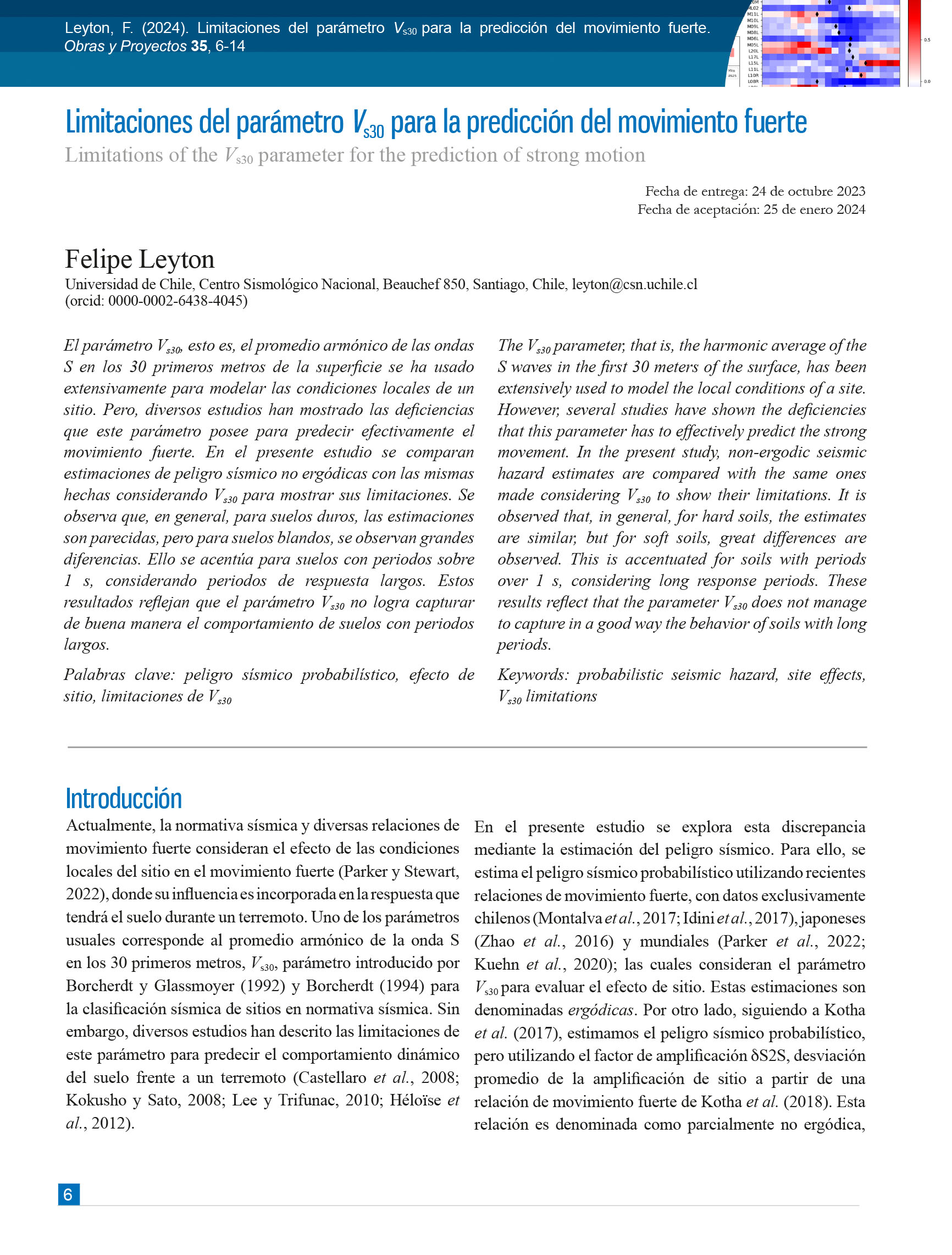Limitaciones del parámetro Vs30 para la predicción del movimiento fuerte
DOI:
https://doi.org/10.21703/0718-2813.2024.35.2794Palabras clave:
Peligro sísmico probabilístico, Efecto de sitio, Limitaciones de Vs30Resumen
El parámetro Vs30, esto es, el promedio armónico de las ondas S en los 30 primeros metros de la superficie se ha usado extensivamente para modelar las condiciones locales de un sitio. Pero, diversos estudios han mostrado las deficiencias que este parámetro posee para predecir efectivamente el movimiento fuerte. En el presente estudio se comparan estimaciones de peligro sísmico no ergódicas con las mismas hechas considerando Vs30 para mostrar sus limitaciones. Se observa que, en general, para suelos duros, las estimaciones son parecidas, pero para suelos blandos, se observan grandes diferencias. Ello se acentúa para suelos con periodos sobre 1 s, considerando periodos de respuesta largos. Estos resultados reflejan que el parámetro Vs30 no logra capturar de buena manera el comportamiento de suelos con periodos largos.
Referencias
Atik, L.A., Abrahamson, N., Bommer, J.J., Scherbaum, F., Cotton, F. and Kuehn, N. (2010). The variability of groundmotion prediction models and its components. Seismological Research Letters 81(5), 794-801.
Barrientos, S. and National Seismological Center (CSN) Team (2018). The seismic network of Chile. Seismological Research Letters 89(2A), 467-474.
Bommer, J.J. (2012). Challenges of building logic trees for probabilistic seismic hazard analysis, Earthquake Spectra 28(4), 1723–1735.
Borcherdt, R.D. (1994). Estimates of site-dependent response spectra for design (methodology and justification). Earthquake Spectra 10(4), 617–653.
Borcherdt, R.D. and Glassmoyer, G. (1992). On the characteristics of local geology and their influence on ground motions generated by the Loma Prieta earthquake in the San Francisco Bay region, California. Bulletin of the Seismological Society of America 82(2), 603-641.
Castellaro, S., Mulargia, F. and Rossi, P.L. (2008). VS30: proxy for seismic amplification?. Seismological Research Letters 79(4), 540-543.
Héloïse, C., Bard, P.Y., Duval, A.M. and Bertrand, E. (2012). Site effect assessment using KiK-net data: part 2—site amplification prediction equation based on f0 and Vsz. Bulletin of Earthquake Engineering 10, 451-489.
Idini, B., Rojas, F., Ruiz, S. and Pastén, C. (2017). Ground motion prediction equations for the Chilean subduction zone. Bulletin of Earthquake Engineering 15(5), 1853-1880.
Kokusho, T. and Sato, K. (2008). Surface-to-base amplification evaluated from KiK-net vertical array strong motion records. Soil Dynamics and Earthquake Engineering 28(9), 707-716.
Kotha, S.R., Cotton, F. and Bindi, D. (2018). A new approach to site classification: Mixed-effects Ground Motion Prediction Equation with spectral clustering of site amplification functions. Soil Dynamics and Earthquake Engineering 110, 318-329.
Kotha, S.R., Bindi, D. and Cotton, F. (2017). From ergodic to region-and site-specific probabilistic seismic hazard assessment: method development and application at European and Middle Eastern sites. Earthquake Spectra 33(4), 1433-1453.
Kuehn, N., Bozorgnia, Y., Campbell, K.W. and Gregor, N. (2020). Partially nonergodic ground-motion model for subduction regions using NGA-Subduction database. PEER Report No. 2020/04. Pacific Earthquake Engineering Research Center, University of California, Berkeley CA, USA.
Lee, V.W. and Trifunac, M.D. (2010). Should average shearwave velocity in the top 30 m of soil be used to describe seismic amplification?. Soil Dynamics and Earthquake Engineering 30(11), 1250-1258.
Leyton, F. y García, B. (2023). La base de datos de movimiento fuerte del Centro Sismológico Nacional. Obras y Proyectos 35, 15-21.
Leyton, F., Leopold, A., Hurtado, G., Pastén, C., Ruiz, S., Montalva, G. and Sáez, E. (2018). Geophysical characterization of the Chilean seismological stations: First results. Seismological Research Letters 89(2A), 519-525.
Leyton, F., Ruiz, S. and Sepúlveda, S.A. (2009). Preliminary reevaluation of probabilistic seismic hazard assessment in Chile: From Arica to Taitao Peninsula. Advances in Geosciencies 22, 147–153.
Martin, A. (1990). Hacia una nueva regionalización y cálculo del peligro sísmico en Chile. Tesis de Magister, Universidad de Chile, Santiago, Chile.
Montalva, G.A., Bastías, N. and Rodriguez‐Marek, A. (2017). Ground‐motion prediction equation for the Chilean subduction zone. Bulletin of the Seismological Society of America 107(2), 901-911.
prNCh433 (2023). Diseño sísmico de edificios. INN, Santiago, Chile.
Parker, G.A. and Stewart, J.P. (2022). Ergodic site response model for subduction zone regions. Earthquake Spectra 38(2), 841-864.
Parker, G.A., Stewart, J.P., Boore, D.M., Atkinson, G.M. and Hassani, B. (2022). NGA-subduction global ground motion models with regional adjustment factors. Earthquake Spectra 38(1), 456-493.
Poulos, A., Monsalve, M., Zamora, N. and de la Llera, J.C. (2019). An updated recurrence model for Chilean subduction seismicity and statistical validation of its Poisson nature. Bulletin of the Seismological Society of America 109(1), 66-74.
Scherbaum, F., Cotton, F. and Smit, P. (2004). On the use of response spectral-reference data for the selection and ranking of ground-motion models for seismic-hazard analysis in regions of moderate seismicity: The case of rock motion. Bulletin of the Seismological Society of America 94(6), 2164-2185.
Scherbaum, F., Delavaud, E. and Riggelsen, C. (2009). Model selection in seismic hazard analysis: An informationtheoretic perspective. Bulletin of the Seismological Society of America 99(6), 3234-3247.
Zhao, J.X., Jiang, F., Shi, P., Xing, H., Huang, H., Hou, R., Zhang, Y., Yu, P., Lan, X., Rhoades, D.A. and Somerville, P.G. (2016). Ground‐motion prediction equations for subduction slab earthquakes in Japan using site class and simple geometric attenuation functions. Bulletin of the Seismological Society of America 106(4), 1535-1551.

Descargas
Publicado
Número
Sección
Licencia

Esta obra está bajo una licencia internacional Creative Commons Atribución-NoComercial 4.0.







